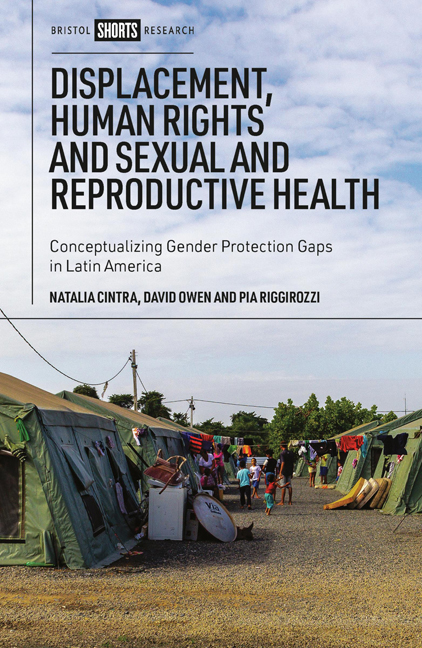 Displacement, Human Rights and Sexual and Reproductive Health
Displacement, Human Rights and Sexual and Reproductive Health Book contents
- Frontmatter
- Dedication
- Contents
- List of Figures and Tables
- Acknowledgements
- Introduction
- One The Gendered Character of Forced Migration
- Two Problematizing the Migrant– Refugee Distinction in Latin America
- Three Latin American Normative Frameworks of Migration and Asylum
- Four Protecting the Human Right to Health of Women and Girls from Venezuela as Necessary Fleers
- Five Responsibility and the Ethics of Forced Displacement in South America
- Conclusion
- Notes
- References
- Index
One - The Gendered Character of Forced Migration
Published online by Cambridge University Press: 18 January 2024
- Frontmatter
- Dedication
- Contents
- List of Figures and Tables
- Acknowledgements
- Introduction
- One The Gendered Character of Forced Migration
- Two Problematizing the Migrant– Refugee Distinction in Latin America
- Three Latin American Normative Frameworks of Migration and Asylum
- Four Protecting the Human Right to Health of Women and Girls from Venezuela as Necessary Fleers
- Five Responsibility and the Ethics of Forced Displacement in South America
- Conclusion
- Notes
- References
- Index
Summary
The current global estimate of forcibly displaced persons is 89.3 million (53.2 million are internally displaced, 27.1 million are refugees, 4.6 million are asylum seekers), a population that has been increasing consistently over the last decade. In 2020, prior to the outbreak of the war in Ukraine, approximately 5 million of those categorized as refugees were women between the ages of 12 and 59; a number that will have risen significantly given the demographics of flight from Ukraine. This global data should draw two points to our attention. First, the issue of forcibly displaced persons is a significant and growing issue. It is, moreover, likely to keep growing given global challenges arising from wars, climate change, food insecurities, and gender-based violence that interact with each other and are not likely to decline any time soon. Second, there has been a ‘feminization’ of forced migration with women and girls making up a large, and increasingly visible, percentage of forced migrants, with many travelling without male spouses or relatives, but also, and more importantly, becoming displaced for gender-related reasons and exposed to gender-related risks in transit and in settlement.
Importantly, almost all conditions surrounding displacement processes exacerbate health vulnerabilities and risk behaviours among women and girls. There is compelling evidence that risks and vulnerabilities faced by displaced women and adolescent girls seriously affect their health, particularly undermining the right to health, and their specific SRH needs and rights (Starrs et al 2018; Wickramage and Annunziata 2018). There is also significant social scientific literature on migration as a determinant of ill-health within displaced populations and on the challenges in displacement, including risks of rape, trafficking, sexual assault, abuse and other risks related to poverty, stigma, discrimination, social exclusion, language, cultural differences and socio-cultural norms, as well as legal status (Valdez et al 2015; Barot 2017; Wolf 2020). Much of this literature has built on studies of conflict-related displacement in places such as Afghanistan, Yemen, Syria, South Sudan and Colombia, and has identified evidence linking displacement with health vulnerabilities of female forced migrants particularly exposed to risks of exploitation, sexual violence, and risky sexual behaviour for (economic) survival leading to increasing numbers of unwanted pregnancies, HIV and sexually transmitted infections (STIs), maternal death and precarity in general (Whelan and Blogg 2007; UNFPA 2009; Freedman 2016, 2017; PAHO 2019a).
- Type
- Chapter
- Information
- Displacement, Human Rights and Sexual and Reproductive HealthConceptualizing Gender Protection Gaps in Latin America, pp. 17 - 44Publisher: Bristol University PressPrint publication year: 2023
